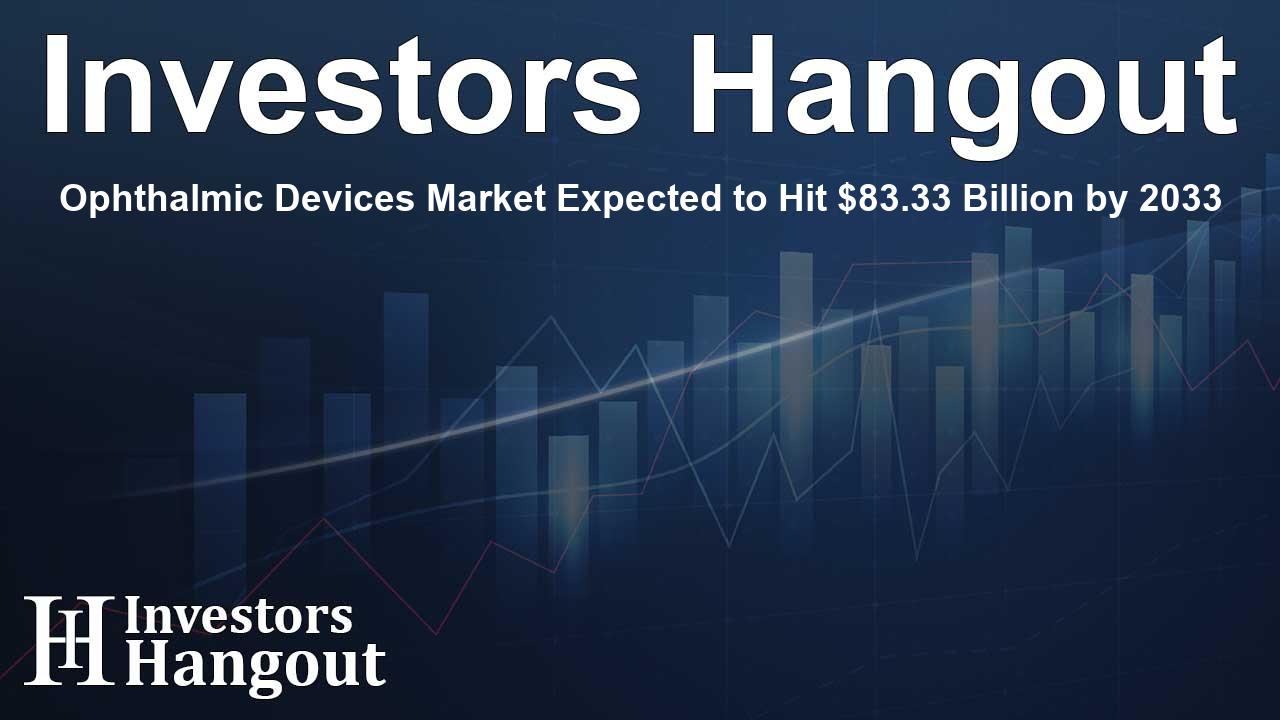Ophthalmic Devices Market Expected to Hit $83.33 Billion by 2033

The Future of the Ophthalmic Devices Market
The ophthalmic devices market is on a remarkable trajectory, expected to grow from its valuation of $47.28 billion in 2024 to an impressive $83.33 billion by 2033. This forecast translates into a significant compound annual growth rate (CAGR) of 6.5% during the period from 2025 to 2033. The growth is spurred by extensive technological advancements, heightened consumer awareness regarding eye health, and robust investments in research and development (R&D).
Key Drivers Fueling Market Growth
A variety of factors are propelling the expansion of the ophthalmic devices market. Firstly, the increasing aging population worldwide is projected to boost demand for corrective vision solutions. Furthermore, the rising prevalence of diabetes has led to a sharper rise in conditions like diabetic retinopathy, thereby boosting the adoption of diagnostic devices aimed at early detection and treatment.
Technological Innovations
Innovative surgical technologies and smart devices are significant contributors to growth in the ophthalmic sector. Companies are heavily investing in R&D to develop cutting-edge products that cater to the dynamic needs of patients. For instance, devices like femtosecond laser-assisted surgery tools have gained traction due to their precision and efficiency, transforming typical procedures into more patient-friendly options.
Market Segmentation
The ophthalmic devices market can be divided into key segments, including vision care products, surgical devices, and diagnostic monitoring devices. Contact lenses stand out in the vision care category, while cataract surgical devices dominate the surgical segment — collectively enjoying a significant market share. Additionally, diagnostic devices are essential for accurate patient monitoring and intervention.
Regional Insights into Market Leadership
North America is leading the global ophthalmic devices market, with an impressive market share driven by strong consumer acceptance and a robust healthcare infrastructure. The region benefits from advanced surgical equipment and diagnostic tools, enhancing the consumer experience and firmly establishing North America's dominance in the industry. The increasing availability of innovative surgical instruments further enhances the competitive advantage held by players in this region.
Competitive Landscape
In the competitive arena of ophthalmic devices, several key players hold significant market shares. Companies like EssilorLuxottica, Alcon, and Bausch + Lomb lead the way with strategic partnerships, innovative product lines, and extensive distribution networks. Essilor's combined expertise in lens technology and Luxottica’s strength in eyewear brand development manifests in their significant market dominance.
Challenges in the Ophthalmic Devices Sector
While the market shows great promise, several challenges affect its expansion. Regulatory hurdles can delay the introduction of innovative products, as stringent approvals are necessary to ensure safety and efficacy. Moreover, the high costs associated with advanced devices may restrict their adoption in low- to middle-income countries. Addressing these complexities requires a focused approach on streamlining clinical trials and regulatory processes.
The Growing Shift Towards Sustainability
Another emerging trend within the ophthalmic market is a notable shift towards sustainable practices. Companies are increasingly embracing environmental responsibility by adopting eco-friendly materials and processes in the manufacturing of contact lenses and other related products. This conscientious shift not only appeals to environmentally aware consumers but also positions companies favorably in a competitive landscape.
Future Outlook
Looking ahead, the ophthalmic devices market is poised for continued growth, driven by both innovation and consumer demand. Stakeholders who prioritize R&D and embrace strategic partnerships stand to capitalize on the evolving landscape of ophthalmology. By focusing on sustainability and emerging technologies, industry players can create a more effective and eco-friendly environment for eye care solutions.
Frequently Asked Questions
1. What is the projected size of the ophthalmic devices market by 2033?
The market is anticipated to reach approximately $83.33 billion by 2033.
2. What factors are driving growth in this market?
Key drivers include an aging population, rising diabetes prevalence, and technological advancements in surgical devices.
3. Which is the leading region in the ophthalmic devices market?
North America currently holds the largest share due to its robust healthcare infrastructure and innovation in eye care technologies.
4. What are the main challenges facing the ophthalmic devices market?
Challenges include regulatory hurdles, high costs limiting device adoption, and reimbursement complexities.
5. How is sustainability impacting the ophthalmic devices market?
Companies are increasingly adopting sustainable practices, which not only attract eco-conscious consumers but also enhance their competitive edge.
About The Author
Contact Logan Wright privately here. Or send an email with ATTN: Logan Wright as the subject to contact@investorshangout.com.
About Investors Hangout
Investors Hangout is a leading online stock forum for financial discussion and learning, offering a wide range of free tools and resources. It draws in traders of all levels, who exchange market knowledge, investigate trading tactics, and keep an eye on industry developments in real time. Featuring financial articles, stock message boards, quotes, charts, company profiles, and live news updates. Through cooperative learning and a wealth of informational resources, it helps users from novices creating their first portfolios to experts honing their techniques. Join Investors Hangout today: https://investorshangout.com/
The content of this article is based on factual, publicly available information and does not represent legal, financial, or investment advice. Investors Hangout does not offer financial advice, and the author is not a licensed financial advisor. Consult a qualified advisor before making any financial or investment decisions based on this article. This article should not be considered advice to purchase, sell, or hold any securities or other investments. If any of the material provided here is inaccurate, please contact us for corrections.
